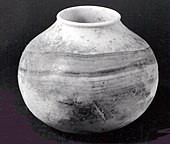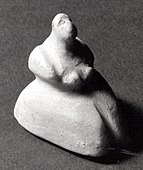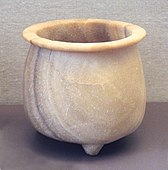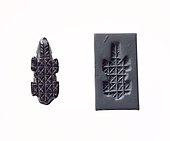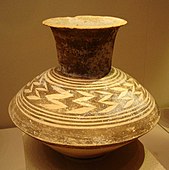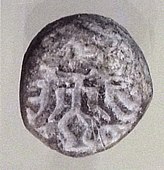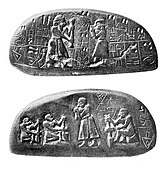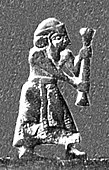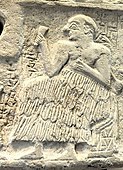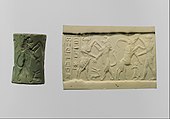
A | B | C | D | E | F | G | H | CH | I | J | K | L | M | N | O | P | Q | R | S | T | U | V | W | X | Y | Z | 0 | 1 | 2 | 3 | 4 | 5 | 6 | 7 | 8 | 9
Gudea of Lagash was famous for his numerous portrait sculptures that have been recovered throughout Iraq.
| History of art |
|---|
The art of Mesopotamia has survived in the record from early hunter-gatherer societies (8th millennium BC) on to the Bronze Age cultures of the Sumerian, Akkadian, Babylonian and Assyrian empires. These empires were later replaced in the Iron Age by the Neo-Assyrian and Neo-Babylonian empires. Widely considered to be the cradle of civilization, Mesopotamia brought significant cultural developments, including the oldest examples of writing.
The art of Mesopotamia rivalled that of Ancient Egypt as the most grand, sophisticated and elaborate in western Eurasia from the 4th millennium BC until the Persian Achaemenid Empire conquered the region in the 6th century BC. The main emphasis was on various, very durable, forms of sculpture in stone and clay; little painting has survived, but what has suggests that, with some exceptions,[1] painting was mainly used for geometrical and plant-based decorative schemes, though most sculptures were also painted. Cylinder seals have survived in large numbers, many with complex and detailed scenes despite their small size.
Mesopotamian art survives in a number of forms: cylinder seals, relatively small figures in the round, and reliefs of various sizes, including cheap plaques of moulded pottery for the home, some religious and some apparently not.[2] Favourite subjects include deities, alone or with worshippers, and animals in several types of scenes: repeated in rows, single, fighting each other or a human, confronted animals by themselves or flanking a human or god in the Master of Animals motif, or a Tree of Life.[3]
Stone stelae, votive offerings, or ones probably commemorating victories and showing feasts, are also found from temples, which unlike more official ones lack inscriptions that would explain them;[4] the fragmentary Stele of the Vultures is an early example of the inscribed type,[5] and the Assyrian Black Obelisk of Shalmaneser III a large and well preserved late one.[6]
Prehistoric Mesopotamia

The highland regions of Mesopotamia were occupied since the Neanderthal times, for example at the site of Shanidar Cave (65,000–35,000 years ago), but with no known artistic creation.[7][8] The first artistic productions of Mesopotamia appear in the area of Upper Mesopotamia only, at the end of the Neolithic during the Pre-Pottery Neolithic A period, with simple representations of humans and animals as well as megaliths (9,500–8,000 BC). This succeeds an earlier period of development in the Levant, as in the Hayonim Cave, were carvings of animals such as horses are known from the earliest dates of the Upper Paleolithic, with dates ranging from 40,000 to 18,500 BP.[9][10][11][12]
In Prehistoric and Ancient Mesopotamia, the climate was cooler than in Egypt or the Indus Valley, meaning that the valleys of the Tigris and Euphrates rivers were very different from the deserts of today; in the highlands there were bands of forest interspersed with steppes and savannas rich in flora and abounding with goats, boars, deers, and fox. After the invention of agriculture, farmers worked in the valley, but the community lived in the more easily fortifiable hills. Unlike in China and the Indus Valley civilization, the villages had two economic orientations, downhill to the fields of grain and uphill into the mountains of Anatolia with their rich mines of gold and copper. Mesopotamian cultures were thus continually in a state of flux, which had its own advantages and difficulties.
Art of the Pre-Pottery Neolithic period (circa 9000–7000 BC)
Pre-Pottery Neolithic A
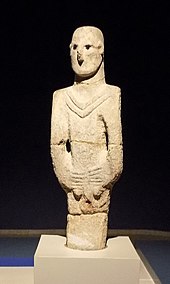
Following the Epipalaeolithic period in the Near East, several Pre-Pottery Neolithic A sites are known from the areas of Upper Mesopotamia and the northern mountainous fringes of Mesopotamia, marked by the appearance around 9000 BC on the banks of the Upper Euphrates of the world's oldest known megaliths at Göbekli Tepe,[16] and the first known use of agriculture around the same time at Tell Abu Hureyra, a site from the preceding Natufian culture.[17]
Numerous realistic reliefs and a few sculptures of animals, as well as fragments of reliefs of humans or deities, are known from Göbekli Tepe and dated to circa 9000 BC. The Urfa Man found in another site nearby is dated to the period of the Pre-Pottery Neolithic circa 9000 BC, and is considered as "the oldest naturalistic life-sized sculpture of a human".[13][14][15] Slightly later, early human statuettes in stone and fired clay have been found in other Upper Mesopotamia sites such as Mureybet, dated to 8500–8000 BC.[18][19]
Pre-Pottery Neolithic B
Around 8000 BC, during the following period of Pre-Pottery Neolithic B, still before the invention of pottery, several early settlements became experts in crafting beautiful and highly sophisticated containers from stone, using materials such as alabaster or granite, and employing sand to shape and polish. Artisans used the veins in the material to maximum visual effect. Such object have been found in abundance on the upper Euphrates river, in what is today eastern Syria, especially at the site of Bouqras.[20]
In northeastern Mesopotamia, the Jarmo culture (7500 BC), centered on the site of Jarmo (Qal'at Jarmo) is a prehistoric archeological site located in modern Iraq on the foothills of the Zagros Mountains. Excavations revealed that Jarmo was an agricultural community, dating back to 7500 BC, based on irrigation through natural rainfall. It preceded the human expansion towards the alluvial plains of central Mesopotamia. It was broadly contemporary with such other important Neolithic sites such as Jericho in the southern Levant, Çatalhöyük in Anatolia or Tell Sabi Abyad in northern Syria. Some fragments of stone vessels and alabaster jars have also been found in Jarmo, dating to circa 7500 BC, before the c.7000 BC invention of pottery.[21][22][23]
-
Jar in calcite alabaster, Syria, late 8th millennium BC.
-
Female statuette, 8th millennium BC, Syria.
-
Alabaster pot Mid-Euphrates region, 6500 BC, Louvre Museum
First experiments with pottery (circa 7000 BC)

The northern Mesopotamian sites of Tell Hassuna and Jarmo are some of the oldest sites in the Near-East where pottery has been found, appearing in the most recent levels of excavation, which dates it to the 7th millennium BC.[21] This pottery is handmade, of simple design and with thick sides, and treated with a vegetable solvent.[25] There are clay figures, zoomorphic or anthropomorphic, including figures of pregnant women which are taken to be fertility goddesses, similar to the Mother Goddess of later Neolithic cultures in the same region.
Halaf culture (6000–5000 BC, Northwestern Mesopotamia)
Pottery was decorated with abstract geometric patterns and ornaments, especially in the Halaf culture, also known for its clay fertility figurines, painted with lines. Clay was all around and the main material; often modelled figures were painted with black decoration. Carefully crafted and dyed pots, especially jugs and bowls, were traded. As dyes, iron oxide containing clays were diluted in different degrees or various minerals were mixed to produce different colours.
The Halaf culture saw the earliest known appearance of stamp seals.[26] They featured essentially geometric patterns.[26]
Female fertility figurines in painted clay, possibly goddesses, also appear in this period, circa 6000–5100 BC.[27]
-
Jar decorated with diverse geometric patterns; 4900–4300 BC; ceramic; by Halaf culture; Erbil Civilization Museum (Erbil, Iraq)
-
Shard; 5600–5000 BC; painted ceramic; 7.19 × 4.19 cm; by Halaf culture
-
Halaf culture female figurines, 6000–5100 BC Louvre Museum
-
Stamp seal and modern impression- geometric pattern. Halaf culture
Hassuna culture (6000–5000 BC, Northern Mesopotamia)
The Hassuna culture is a Neolithic archaeological culture in northern Mesopotamia dating to the early sixth millennium BC. It is named after the type site of Tell Hassuna in Iraq. Other sites where Hassuna material has been found include Tell Shemshara. The decoration of pottery essentially consists in geometrical shapes, and a few ibex designs.
Samarra culture (6000–4800 BC, Central Mesopotamia)
The Samarra culture is a Chalcolithic archaeological culture in northern Mesopotamia that is roughly dated to 5500–4800 BCE. It partially overlaps with the Hassuna and early Ubaid.
-
Samarra plate, with an abstract rim, a circle of eight fish, and four birds catching four fish that swim towards a central swastika; circa 4000 BC; painted ceramic; diameter: 27.7 cm; Vorderasiatisches Museum Berlin
-
Samarra period fine ware, with central Ibex motif; circa 6200–5700 BC; Vorderasiatisches Museum
-
Female figurine found in the Tell es Sawwan (middle Tigris, near Samarra), level 1; circa 6000 BC; alabaster; Louvre
-
Fragment of Samarra pottery with geometrical designs in University of Chicago Oriental Institute (USA)
Ubaid culture (c. 6500–3800 BC, Southern Mesopotamia)

The Ubaid period (c. 6500–3800 BC)[28] is a prehistoric period of Mesopotamia. The name derives from Tell al-'Ubaid in Southern Mesopotamia, where the earliest large excavation of Ubaid period material was conducted initially by Henry Hall and later by Leonard Woolley.[29]
In South Mesopotamia the period is the earliest known period on the alluvial plain although it is likely earlier periods exist obscured under the alluvium.[30] In the south it has a very long duration between about 6500 and 3800 BC when it is replaced by the Uruk period.[31]
In North Mesopotamia, Ubaid culture expanded during the period between about 5300 and 4300 BC.[31] It is preceded by the Halaf period and the Halaf-Ubaid Transitional period and succeeded by the Late Chalcolithic period. The new period is named Northern Ubaid to distinguish it from the proper Ubaid in southern Mesopotamia.[32]
With Ubaid 3 (circa 4500 BC) numerous examples of Ubaid pottery have been found along the Persian Gulf, as far as Dilmun, where Indus Valley civilization pottery has also been found.[33]
Stamps seals start to depict animals in stylistic fashion, and also bear the first known depiction of the Master of Animals at the end of the period, circa 4000 BC.[34][35][36]
-
Jar; Late Ubaid period (4500–4000 BC); pottery; from Southern Iraq; Museum of Fine Arts, Boston (USA)
-
Lizard-headed nude woman nursing a child, Ur, Ubaid 4 period, 4500-4000 BCE, Iraq Museum. "The elongated head, similar to the figures found at Eridu, could represent an elaborate headdress or possibly cranial binding".[38]
-
Terracotta stamp seal with Master of Animals motif, Tello, ancient Girsu, End of Ubaid period, Louvre Museum AO14165. circa 4000 BC.[34]
Historic Mesopotamia
Sumerian period (c. 4000–2270 BC)
The rise of the non-Semitic-speaking Sumerian culture spans a period of about two millennia, and saw the development of sophisticated artistic traditions, as well as the invention of writing, first through pictographic signs, and then through cuneiforms.
Pre-Dynastic period: Uruk (c. 4000 to 3100 BC)

The Protoliterate or Uruk period, named after the city of Uruk in southern Mesopotamia, (ca. 4000 to 3100 BC) existed from the protohistoric Chalcolithic to Early Bronze Age period, following the Ubaid period and succeeded by the Jemdet Nasr period generally dated to 3100–2900 BC.[39] It saw the emergence of urban life in Mesopotamia, and the beginnings of Sumerian civilization,[40] and also the first "great creative age" of Mesopotamian art.[41] Slightly earlier, the northern city of Tell Brak, today in Syria, also saw urbanization, and the development of a temple with regional significance. This is called the Eye Temple after the many "eye idols", in fact votive offerings, found there, a type distinctive to this site. The stone Tell Brak Head, 7 inches high, shows a simplified face; similar heads are in gypsum. These were evidently fitted to bodies that have not survived, probably of wood.[42] Like temples further south, the Eye Temple was decorated with cone mosaics made up of clay cylinders some four inches long, differently coloured to create simple patterns.[43]
Significant works from the southern cities in Sumer proper are the Warka Vase and Uruk Trough, with complex multi-figured scenes of humans and animals, and the Mask of Warka. This is a more realistic head than the Tell Brak examples, like them made to top a wooden body; what survives of this is only the basic framework, to which coloured inlays, gold leaf hair, paint and jewellery were added.[44] It could depict a temple goddess. Shells may have served as the whites of the eyes, and the lapis lazuli, a beautiful, blue semi-precious gemstone, may have formed the pupils.[45] The Guennol Lioness is an exceptionally powerful small figurine of a lion-headed monster,[46] perhaps from the start of the next period.
There are a number of stone or alabaster vessels carved in deep relief, and stone friezes of animals, both designed for temples, where the vessels held offerings. Cylinder seals are already complex and very finely executed and, as later, seem to have been an influence on larger works. Animals shown are often representations of the gods, another continuing feature of Mesopotamian art.[47] The end of the period, despite being a time of considerable economic expansion, saw a decline in the quality of art, perhaps as demand outstripped the supply of artists.[48]
-
Eye idol; 3700–3500 BC; gypsum alabaster; 6.5 × 4.2 × 0.6 cm; Metropolitan Museum of Art
-
The original Warka Vase, in the National Museum of Iraq. It is one of the earliest surviving works of narrative relief sculpture, dated to c. 3200–3000 BC.[51]
-
Sculpture of the ritually nude 'Priest-King', Late Uruk, Louvre.
-
Cylinder seal with serpopards (monstrous lions) and lion-headed eagles; 4100–3000 BC; jasper; Louvre. This design was also adopted in Egypt as a consequence of Egypt-Mesopotamia relations.
-
Tablets with proto-cuneiform pictographic characters, were used for noting commercial transactions (end of 4th millennium BC), Uruk III.
Early artistic exchanges with Egypt (c. 3500–3200 BC)edit
(3400–3200 BC)
Egypt–Mesopotamia relations seem to have developed from the 4th millennium BCE, starting in the Uruk period for Mesopotamia and the Gerzean culture of pre-literate Prehistoric Egypt (circa 3500–3200 BC).[59][60] Influences can be seen in the Pre-Dynastic Art of Ancient Egypt, in imported products, and also in the possible transfer of writing from Mesopotamia to Egypt,[60] and generated "deep-seated" parallels in the early stages of both cultures.[61]
Distinctly Mesopotamian objects and art forms entered Egypt during this period, indicating exchanges and contacts. The designs that were emulated by Egyptian artists are numerous: the Uruk "priest-king" with his tunique and brimmed hat in the posture of the Master of animals, the serpopards or sepo-felines, winged griffins, snakes around rosettes, boats with high prows, all characteristic of Mesopotamian art of the Late Uruk (Uruk IV, c. 3350–3200 BC) period.[62][63] The same "Priest-King" in visible in several Mesopotamian works of art of the end of the Uruk period, such as the Blau Monuments, cylinder seals and statues.[64]
Pre-Dynastic period: Jemdet Nasr (3100–2900 BC)edit
The Jemdet Nasr Period covers the period from 3100 to 2900 BC. It is named after the type site Tell Jemdet Nasr, where the assemblage typical for this period was first recognized. Its geographical distribution is limited to south-central Iraq. The culture of the proto-historical Jemdet Nasr period is a local development out of the preceding Uruk period and continues into the Early Dynastic I period. The period is characterized by splendidly painted monochrome and polychrome pottery, as well as the appearance of large proto-cuneiform tablets, clearly going beyond the initial pictographic writing.
-
Djemdet Nasr stone bowl, once inlaid with mother-of-pearl, red paste, and bitumen.
-
Cup with Nude Hero, Bulls and Lions, Tell Agrab, Jamdat Nasr to Early Dynastic period, 3000–2600 BC.
-
Stele of lion hunt, Uruk, Iraq, 3000-2900 BCE. National Museum of Iraq
-
The Blau Monuments combine proto-cuneiform characters and illustrations, 3100–2700 BC. British Museum.
Pre-Dynastic dress (4000-2700 BC): kilts and "net-dresses"edit
The earliest type of dress attested in early Sumerian art is not the kaunakes, but rather a sort of kilt or "net dress" which is quite closely fitting the lower body, while the upper body remains bare.[65] This early type of net dress looks much more similar to standard textile then the later kaunakes, which looks more like sheepskin with ample bell-shaped volume around the waist and the legs.[65][66]
-
Cylinder seal from Uruk, with "net-dress", 3100 BC
-
A "net dress" being worn on the Blau Monuments (3000-2900 BC)
-
A kilt or "net-dress" on the Blau Monuments (3000-2900 BC)
Early Dynastic period (2900–2350 BC)edit
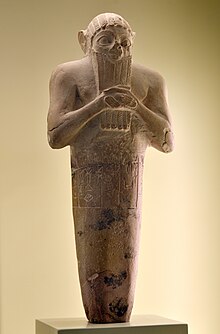
The Early Dynastic Period is generally dated to 2900–2350 BC. While continuing many earlier trends, its art is marked by an emphasis on figures of worshippers and priests making offerings, and social scenes of worship, war and court life. Copper becomes a significant medium for sculpture, probably despite most works having later being recycled for their metal.[68] Few if any copper sculptures are as large as the Tell al-'Ubaid Lintel, which is 2.59 metres wide and 1.07 metres high.[69]
Many masterpieces have also been found at the Royal Cemetery at Ur (c. 2650 BC), including the two figures of a Ram in a Thicket, the Copper Bull and a bull's head on one of the Lyres of Ur.[70] The so-called Standard of Ur, actually an inlaid box or set of panels of uncertain function, is finely inlaid with partly figurative designs.[71]
A group of 12 temple statues known as the Tell Asmar Hoard, now split up, show gods, priests and donor worshippers at different sizes, but all in the same highly simplified style. All have greatly enlarged inlaid eyes, but the tallest figure, the main cult image depicting the local god, has enormous eyes that give it a "fierce power".[72] Later in the period this geometric style was replaced by a strongly contrasting one giving "a detailed rendering of the physical peculiarities of the subject"; "Instead of sharply contrasting, clearly articulated masses, we see fluid transitions and infinitely modulated surfaces".[73]
-
Sumerian headgear necklaces. British museum.
-
Ram in a Thicket; 2600–2400 BC; gold, copper, shell, lapis lazuli and limestone; height: 45.7 cm; from the Royal Cemetery at Ur; British Museum
-
Bull's head from the Queen's Lyre from Pu-abi's grave, Ur, c. 2600 BC
-
Master of animals motif in a panel of the soundboard of the Ur harp
-
Man carrying a box, possibly for offerings. Metalwork, ca. 2900–2600 BCE, Sumer. Metropolitan Museum of Art.
-
Battle scene, with phalanx led by King Eannatum, on the Stele of the Vultures, Early Dynastic III period, 2600–2350 BC
-
Gold helmet of Meskalamdug, ruler of the First Dynasty of Ur, circa 2500 BC, Early Dynastic period III.
-
King Ur-Nanshe, seated, wearing flounced skirt. Limestone, Early Dynastic III (2550–2500 BC). Found in Telloh (ancient city of Girsu). Louvre Museum.[74][75][76]
-
Standard of Ur; 2600–2400 BC; shell, red limestone and lapis lazuli on wood; length: 49.5 cm; from the Royal Cemetery at Ur; British Museum
-
Ring of Gold, Carnelian, Lapis Lazuli, Tello, ancient Girsu, mid-3rd millennium BC.
-
A Sumerian group of two separate shell inlay fragments forming the body and head of a sheep. Circa 27th - 24th Century BC. From a Mayfair gallery, London, UK.
Akkadian Empire period (c. 2271–2154 BC)edit

The Akkadian Empire was the first to control not only all Mesopotamia, but other territories in the Levant, from about 2271 to 2154 BC. The Akkadians were not Sumerian, and spoke a Semitic language. In art there was a great emphasis on the kings of the dynasty, alongside much that continued earlier Sumerian art. In large works and small ones such as seals, the degree of realism was considerably increased,[79] but the seals show a "grim world of cruel conflict, of danger and uncertainty, a world in which man is subjected without appeal to the incomprehensible acts of distant and fearful divinities who he must serve but cannot love. This sombre mood ... remained characteristic of Mesopotamian art..."[80]
King Naram-Sin's famous Victory Stele depicts him as a god-king (symbolized by his horned helmet) climbing a mountain above his soldiers, and his enemies, the defeated Lullubi. Although the stele was broken off at the top when it was stolen and carried off by the Elamite forces of Shutruk-Nakhunte, it still strikingly reveals the pride, glory, and divinity of Naram-Sin. The stele seems to break from tradition by using successive diagonal tiers to communicate the story to viewers, however, the more traditional horizontal frames are visible on smaller broken pieces. It is 6 feet 7 inches (2.01 m) tall, and made from pink sandstone.[81][82] From the same reign, the bare legs and lower torso of the copper Bassetki Statue show an unprecedented level of realism, as does the imposing bronze head of a bearded ruler (Louvre).[83]
The Louvre head is a life-size, bronze bust found in Nineveh. The intricate curling and patterning of the beard and the complex hairstyle suggests royalty, power, and wealth from an ideal male in society. Aside from its aesthetic traits, this piece is spectacular because it is the earliest hollow-cast sculpture item known to use the lost-wax casting process.[84] There is deliberate damage on the left side of the face and eye, indicating that the bust was intentionally slashed at a later period to demonstrate political iconoclasm.[85]
-
Bronze head of an Akkadian ruler, discovered in Nineveh in 1931, presumably depicting either Sargon of Akkad or Sargon's grandson Naram-Sin.[86]
-
The copper Bassetki Statue
-
Akkadian language inscription on the obelisk of Manishtushu
-
Detail of a victory stele of Akkadian king Rimush
-
Seal impression with gods and water buffaloes, thought to have been imported from the Indus Valley civilization, an example of Indus-Mesopotamia relations at the time.
-
Cylinder seal and modern impression – bull-man combatting lion; nude hero combatting water buffalo; 2250–2150 BC; albite; height: 3.4 cm, diameter: 2.3 cm; Metropolitan Museum of Art (New York City)
-
Goddess Ishtar on an Akkadian Empire seal, 2350–2150 BC. She is equipped with weapons in her back, has a horned helmet, and is trampling a lion.
Neo-Sumerian period (c. 2112–2004 BC)edit
After the fall of the Akkadian Empire, a local dynasty emerged in Lagash. Gudea, ruler of Lagash (reign ca. 2144 to 2124 BC), was a great patron of new temples early in the period, and an unprecedented 26 statues of Gudea, mostly rather small, have survived from temples, beautifully executed, mostly in "costly and very hard diorite" stone. These exude a confident serenity.[88]
The northern Royal Palace of Mari produced a number of important objects from before about 1800 BC, including the Statue of Iddi-Ilum,[89] and the most extensive remains of Mesopotamian palace frescos.[90]
The Neo-Sumerian art of the Third Dynasty of Ur reached new heights, especially in terms of realism and fine craftmanship.
-
Statue of Gudea P; circa 2090 BC; diorite; height: 44 cm, width: 21.5 cm, depth: 29.5 cm; Metropolitan Museum of Art
-
Portrait of Ur-Ningirsu. Louvre Museum
Zdroj:https://en.wikipedia.org?pojem=Art_of_Mesopotamia
Text je dostupný za podmienok Creative Commons Attribution/Share-Alike License 3.0 Unported; prípadne za ďalších podmienok. Podrobnejšie informácie nájdete na stránke Podmienky použitia.
Antropológia
Aplikované vedy
Bibliometria
Dejiny vedy
Encyklopédie
Filozofia vedy
Forenzné vedy
Humanitné vedy
Knižničná veda
Kryogenika
Kryptológia
Kulturológia
Literárna veda
Medzidisciplinárne oblasti
Metódy kvantitatívnej analýzy
Metavedy
Metodika
Text je dostupný za podmienok Creative
Commons Attribution/Share-Alike License 3.0 Unported; prípadne za ďalších
podmienok.
Podrobnejšie informácie nájdete na stránke Podmienky
použitia.
www.astronomia.sk | www.biologia.sk | www.botanika.sk | www.dejiny.sk | www.economy.sk | www.elektrotechnika.sk | www.estetika.sk | www.farmakologia.sk | www.filozofia.sk | Fyzika | www.futurologia.sk | www.genetika.sk | www.chemia.sk | www.lingvistika.sk | www.politologia.sk | www.psychologia.sk | www.sexuologia.sk | www.sociologia.sk | www.veda.sk I www.zoologia.sk


